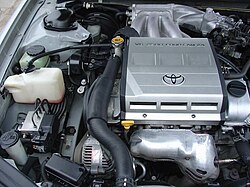Toyota MZ engine
| Toyota MZ engine | |
|---|---|
 | |
| Overview | |
| Manufacturer | Toyota Motor Corporation |
| Production | 1993–2014 |
| Layout | |
| Configuration | V6 |
| Chronology | |
| Predecessor | Toyota VZ engine |
| Successor | Toyota GR engine |
The Toyota MZ engine family is a V6 piston engine series. The MZ series has an aluminium engine block and aluminium alloy DOHC cylinder heads. The cylinders are lined with cast iron, and is of a closed deck design (no open space between the bores). The engine is a 60 degree V6 design. It uses multiport fuel injection (MFI), four valves per cylinder, a one-piece cast camshaft and a cast aluminium intake manifold. The MZ family is a lightweight V6 engine of an all-aluminium design, using lighter weight parts than the heavier duty VZ block engines in an effort to lower production costs, decrease engine weight, and decrease reciprocating weight without sacrificing reliability. Toyota sought to enhance the drivability pattern of the engine (over the 3VZ) at exactly 3000 rpm, since that was the typical engine speed for motors cruising on the highway. The result was less cylinder distortion coupled with the decreased weight of rotating assemblies, smoother operation at that engine speed, and increased engine efficiency.[citation needed]
They feature cast aluminium pistons with an anti-friction resin coating (moly) and valve depressions that decrease the chance of valve-to-piston interference in case of timing belt failure on motors without VVT-i.[1] They also use steel rings, smaller-diameter shot-peened rods, and a forged steel crankshaft.[2]
This engine has been phased out in most markets, replaced by variants of the new GR series.
1MZ-FE

The 1MZ-FE is a 3.0 L (2994 cc) dual overhead cam (DOHC) V6 engine. Bore is 87.5 mm and stroke is 83 mm. Output is 168–194 hp @ 5200–5400 rpm with 183–209 lb·ft of torque at 4400 rpm. Horsepower ratings dropped after the Society of Automotive Engineers implemented a new power measurement system for vehicle engines, Toyota engines rated on 87 octane dropped the most, compared to the same engines used by Lexus rated on 91 octane. It has bucket tappets and was designed for good fuel economy without an overall performance trade-off. These engines are prone to oil gelling. Another name for the issue was "Engine sludge".[3] There was a class action lawsuit due to this problem.[4] It is very important to the life of these engines that oil changes are done on a regular basis.
The 1MZ-FE was on Ward's 10 Best Engines list for 1996.[citation needed]
Applications:
- 1993–2006 Toyota Camry (V6)
- 1993–2003 Lexus ES 300 & Toyota Windom (Japanese domestic market)
- 1994–2004 Toyota Avalon & 2000 Toyota Pronard (Avalon for Japanese domestic market)
- Toyota Harrier (non-US markets)
- 1997–2000 Toyota Sienna
- 04.1997–12.2001 Toyota Mark II Wagon (Japanese domestic market)
- 1998–2003 Toyota Solara (V6)
- 2000–2005 Toyota Estima (Japanese domestic market)
Toyota Racing Development offered a bolt-on TRD supercharger kit for the MY1997–2000 Camry, MY1998–2000 Sienna and MY1999–2000 Solara. Power output was bumped to 242 hp and 242 lb·ft of torque.
The 1MZ-FE with VVT-i is used in the Avalon, Highlander, Sienna and Camry. Output is 210 hp (156 kW) at 5800 rpm with 222 lb·ft (328 N·m) of torque at 4400 rpm. Early versions of the VVT-i 1MZ used a dual throttle body, cast aluminum intake manifold, and EGR block off plates on the exhaust manifolds. Later versions used a drive-by-wire/electronic throttle control.
Applications:
- 1998–2003 Lexus RX 300 (US market)
- 1999–2003 Lexus ES 300
- 2000–2004 Toyota Avalon
- 2000–2003 Toyota Highlander/Kluger
- 2000–2003 Toyota Sienna
- 2002–2007 Toyota Alphard (Japanese domestic market)
- 2003–2006 Toyota Camry (V6)
2MZ-FE

The 2MZ-FE is a 2.5 L (2496 cc) engine replacing the 4VZ-FE as the worldwide 2.5 L V6. Bore is 87.5 mm and stroke is 69.2 mm. Output is 200 hp (150 kW) at 6000 rpm with torque of 180 lb⋅ft (244 N⋅m) at 4600 rpm.
Applications:
- Toyota Camry (Japanese, NZ and some other Non-US markets)
- Toyota Windom (Japanese domestic market)
- 04.1997–12.2001 Toyota Mark II Wagon (Japanese domestic market)
3MZ-FE
The 3MZ-FE is a 3.3 L (3310 cc) version. Bore is 92 mm and stroke is 83 mm. Output is 225 hp (168 kW) with 240 lb⋅ft (325 N⋅m) of torque in the Camry and 230 hp (172 kW) with 242 lb⋅ft (328 N⋅m) of torque in the Sienna and Highlander. It also features VVT-i, ETCS-i (Electronic Throttle Control System — intelligent/DBW), ABS plastic intake, and increased throttle body diameter over the 1MZ. The 3MZ uses a new flat-type knock sensor, which is a departure from the typical resonator type knock sensor used on the previous MZs. Previous MZs had poor knock control, or perhaps oversensitivity when detecting knock, and power loss up to 20 hp (15 kW) may be realized due to erratic ignition timing when using an octane lower than 91. The new flat-type knock sensor is a completely different design and detects more frequencies than the traditional resonator type. This provides the ECU with more accurate data. A bolt goes through the center of the knock sensor, which then mates the sensor to the block on each bank.
Applications:
- 2003–2007 Toyota Highlander
- 2003–2008 Toyota Camry Solara (V6)
- 2003–2006 Toyota Sienna
- 2005–2006 Toyota Camry (SE V6)
- 2005–2010 Toyota Highlander Hybrid (reduced power output)
- 2003–2006 Lexus RX 330
- 2005–2009 Lexus RX 400h (reduced power output)
- 2003–2006 Lexus ES 330
- 2006-2014 Mitsuoka Orochi
See also
References
- ^ https://axleaddict.com/auto-repair/Toyota-1MZFE-Timing-Belt-Replacement-Camry-Avalon-ES300
- ^ http://australiancar.reviews/3MZ-FE-engine.php
- ^ "The black death of sludge". Consumers Reports. Consumers union. February 2014. Retrieved September 12, 2016.
- ^ http://web.archive.org/web/20070118062627/http://oilgelsettlement.com/summary_notice.pdf
